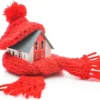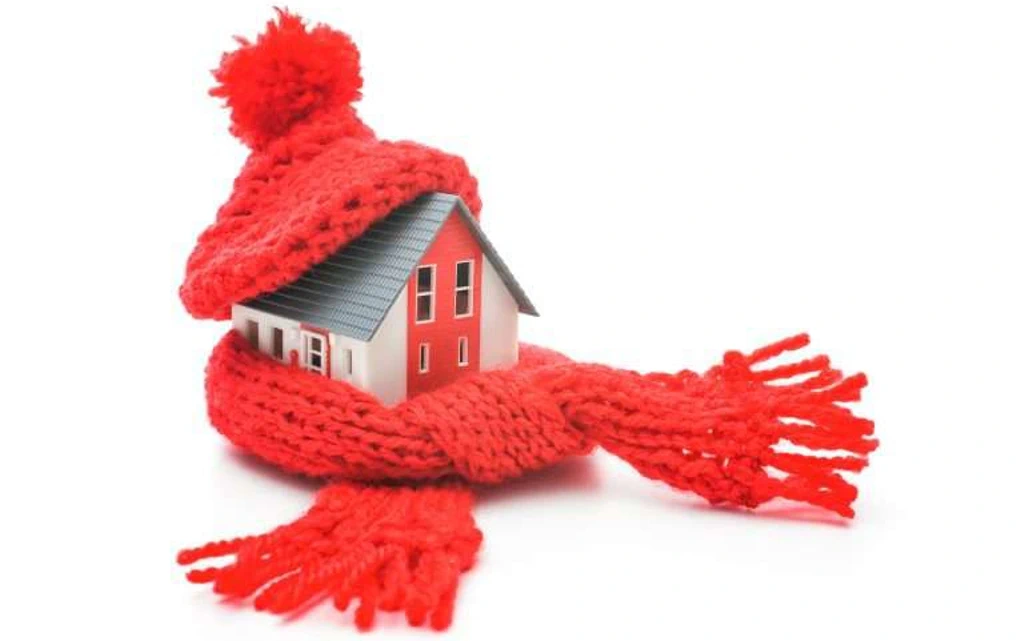 Winter Weather is the last thing many worry about in Texas. So, why do you need to Winterize Your Home in Texas when it’s associated with sunshine and hot weather? While that might be true for much of the year, often it’s not the case during January and February.
Winter Weather is the last thing many worry about in Texas. So, why do you need to Winterize Your Home in Texas when it’s associated with sunshine and hot weather? While that might be true for much of the year, often it’s not the case during January and February.
With North Texas having its share of winter weather lately, it’s not too late to make sure your home is ready and more energy efficient.
Here are some tips on how to get your home ready for the icy temps, plus save yourself some money and hassles later.
Before it gets too cold outside, take advantage of the milder temperatures to perform a few winterization tasks. You’ll reduce energy costs, and keep your indoor climate cozy.
Check Doors and Windows for Air Leaks
If you feel a draft or see daylight through a door or window seam, it’s time to seal those air leaks.
According to energy.gov, air leaks are a primary culprit for wasted energy and can decrease a home’s energy efficiency by 5 to 30% each year.
To begin winterize your home, check the trim around the windows and doors – both inside and out. Gaps as small as 1/64 inch can let in drafts, bugs, and runoff water.
So, how do you check for air leaks?
A professional blower door service conducted by a certified energy specialist is the most thorough and accurate method of detecting energy-wasting air leaks.
However, there are a few other tips to help homeowners detect air leaks:
- Shine a flashlight at night around potential gaps- you will need the help of a partner to spot any light beaming through the other side.
- Close a window or door on a dollar bill. If you can pull it free easily, you are losing energy.
- Hold a candle next to potential gaps and observe how the flame is drawn to or changes direction.
- Hold your hand over the area- this is easy enough to detect on cold or windy days but may not be as obvious on other days.
I found some leaks; now what? Grab your caulk gun and re-caulk the edges, or replace old weather striping to ensure a leak-proof seal.
Home Depot suggests using a silicone caulk for the exterior of your windows and doors to keep water out and a latex caulk or expandable foam on interior seals.
Also, if your budget allows, consider installing storm windows over existing ones or replacing your old windows with new energy-efficient ones.
Other Areas to Check For Air Leaks
In addition to windows and doors, leaks can be found in other areas. We cover many of these below, but here’s a quick list to consider:
- Electrical outlets
- Switch plates
- Recessed and can lighting fixtures
- Electrical and gas service entrances
- Baseboards
- Fireplace dampers
- Attic hatches and vents
- Wall or window-mounted air conditioners
- Cable TV and phone lines
- Dryer vents
- Interior and exterior vents and fans
- Gaps around pipes and wires
Addressing air leaks in your home can help you reduce energy costs and stay warmer this winter.
How to Winterize Your Home Exterior
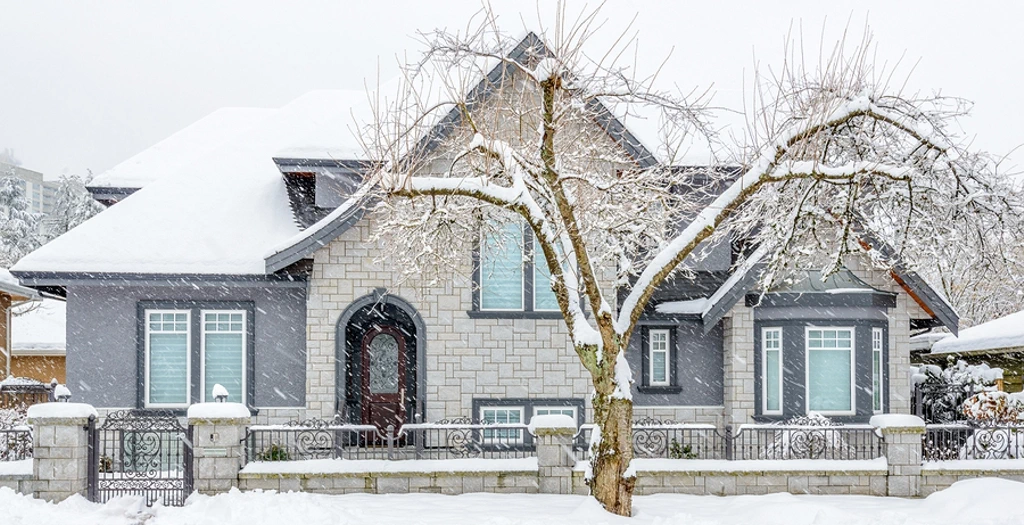 In addition to checking doors and windows for air leaks, now is also a great time to look for other areas where warm air can escape — and cold air can penetrate.
In addition to checking doors and windows for air leaks, now is also a great time to look for other areas where warm air can escape — and cold air can penetrate.
When winterizing your home, a visual inspection of the perimeter should include the following:
- Vents– Check for gaps and holes in exterior vents, including dryer vents, air conditioning units, and exhaust vents for cooking ranges. Plug any holes or gaps with insulating spray foam.
- Drainage– Check to make sure you don’t have water pooling around your foundation. If temperatures drop below freezing, standing water will freeze and expand, which can cause cracks in foundations and pipes. If you find a low spot that tends to hold water, fill it in with some soil and pack it tightly.
- Gutters– During the summer and fall months, gutters can fill up with falling leaves, nests, and other sediments, preventing water from flowing freely. A blocked gutter can lead to ice dams during cold weather temperatures, which can result in expensive water damage to walls, ceilings, and insulation. Also, consider installing gutter guards if you have tall trees. Read more on tips for cleaning gutters.
- Chimney– Before you build those warm, cozy fires this winter, make sure your fireplace and chimney are ready. A visual inspection of the outside chimney may also reveal damage. Double-check the chimney’s masonry for missing brick or tile, and examine the flashing between the chimney and roof tiles to ensure it is properly attached and sealed.
- Roof– While checking the chimney, do a roof inspection and clear away branches and other debris that may have piled up during previous months. Extreme weather like summer heat, strong winds, and hail can damage a roof, which only gets worse over time. Look for large dents or cracks in the roof shingles, loose or missing roof shingles, cracked caulk, loose flashing, or issues with chimney bricks. If you find a problem, call a professional roofing company to do a thorough inspection and repair.
- Garden hoses, pipes, and outdoor faucets – Insulate your outside water pipes. Unhook your garden hoses from the water supply and attach insulated spigot covers to the outside faucet. Home Depot or Lowes each carry many different varieties. Also, any water pipe exposed to the elements (such as the garage or crawlspace pipes) should be wrapped with rubber, spray foam, or fiberglass sleeves.
Of course, some of these DIY projects may not be for everyone. Consider hiring a professional for those you’re not comfortable doing yourself.
Preparing Your Swimming Pool for Winter
We have milder winters in the Frisco and the North Texas area than our friends up North. This weather means we typically don’t experience extreme weather that lasts for more than a few days at a time (except for the Great Texas Freeze of 2021), and pool owners don’t typically drain their pools in the winter.
However, during the cold weather months, there are a few pool winterization maintenance tips to protect pool equipment.
- Freeze Guard: Check the freeze protection unit to ensure it is clean and operating properly.
- Pumps and Filters: Thoroughly clean pumps, filters, and grids so water can flow freely should your freeze guard system activate when temperatures reach below freezing.
- Heater and Water Treatment: If your pool is equipped with one, check that the pool heater and water treatment systems (chlorinator or salt) are working correctly and free of debris.
- Daily Timers: In the winter months, consider setting filtration timers to run at night when the temperatures are the coldest – this saves electricity, as freeze guard systems will likely run at night anyway if daily temperatures fall below freezing.
Winterizing Your Homes Sprinkler System
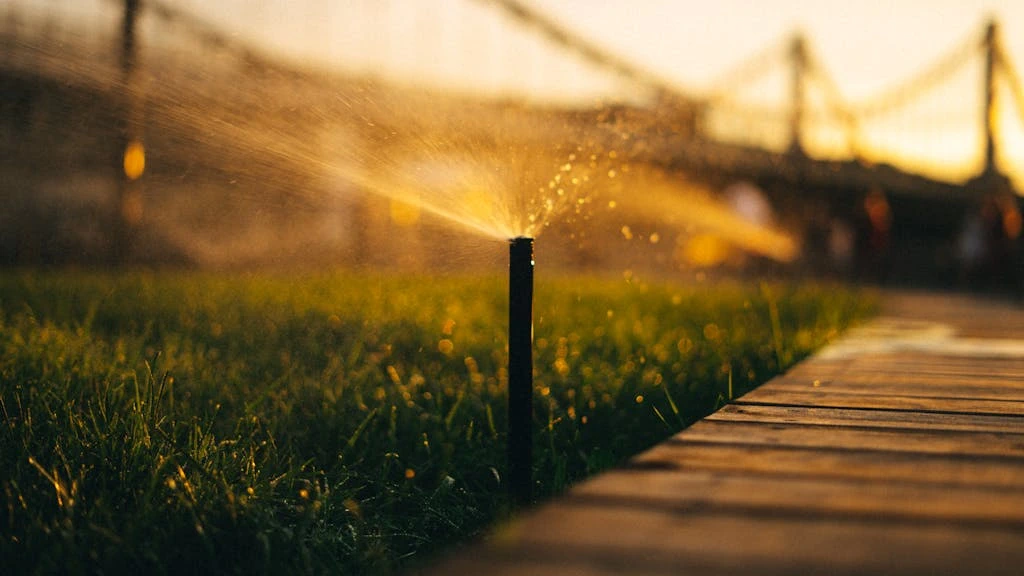 Outdoor irrigation systems are notorious for freezing when cold weather hits. Follow these quick steps to prevent burst pipes and water damage:
Outdoor irrigation systems are notorious for freezing when cold weather hits. Follow these quick steps to prevent burst pipes and water damage:
Many cities in North Texas prohibit winter grasses as part of their water conservation policies. So, if you don’t have to water a lawn full of winter rye grass, it’s a good idea to turn off your irrigation systems since most summer grasses are dormant in the winter months.
But what about keeping my foundation watered? Many do this manually as needed.
While it still rains during a Texas winter, should weeks go by without any, just use the manual mode of your irrigation timer to water the zones that cover your foundation.
Winterizing Your Yard and Landscaping
While many Texas lawns are dormant in the cold weather months, your expensive landscaping may need some TLC to help protect it during extreme cold weather conditions.
Here are a few tips to help protect your home and landscape investments:
- Trim long or heavy tree branches and shrubs to prevent frozen limbs from breaking off and causing damage to your roof, yard, and nearby cars.
- Bring all container-grown and tropical plants indoors or move to covered patio areas during freezing weather.
- Cover bedded plants with burlap or landscape blankets when temperatures dip below 32 degrees.
- Winterize your lawn with a fertilizer appropriate for your type of grass to help protect it from harsh conditions and prepare it for the spring growing season.
- Remove cushions and cover outdoor furniture to prevent damage from freezing temperatures and damaging winds.
Preparing Your Home Heating Systems for Winter
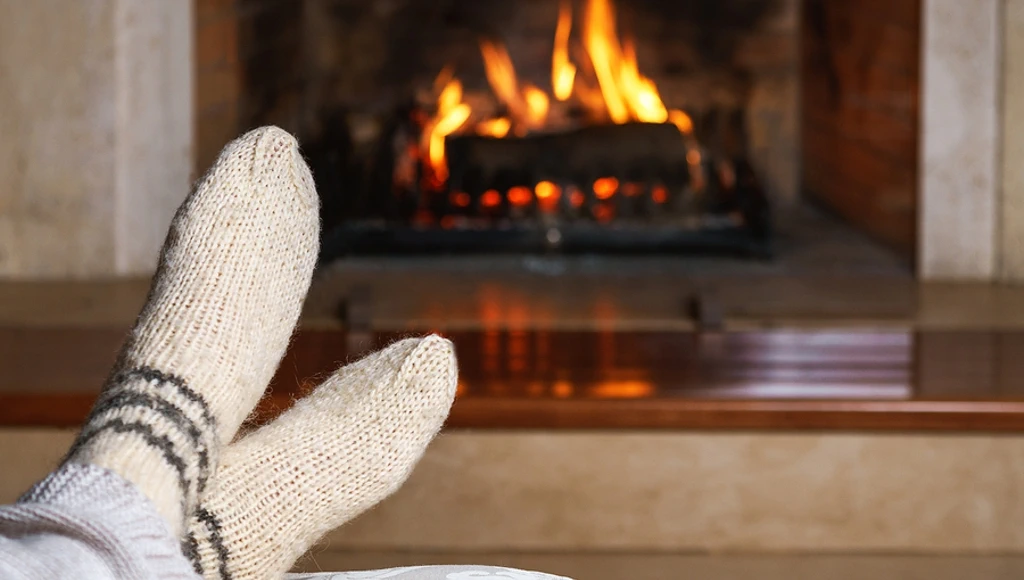 Is it time for winter already? While the “change of seasons” in Texas is always unpredictable, you should still prepare for those Arctic blasts that have become more the norm than the exception here.
Is it time for winter already? While the “change of seasons” in Texas is always unpredictable, you should still prepare for those Arctic blasts that have become more the norm than the exception here.
When winterizing your home, there are several things you can do to prepare your home’s heating systems for the cold temperatures.
Getting a jump on these maintenance items now could save you expensive emergency repair bills. Plus, help reduce your overall energy use.
So, what type of heating system do you have?
There are several options for whole-house heating in Texas, including forced-air furnaces, heat pumps & ductless systems.
Furnaces are very popular in the Frisco and North Texas areas. They are available in gas and electric varieties, with gas furnaces typically having a lower operating cost for our region.
Heat pumps, a combined heating & cooling system, use electricity but are more economical to run than electric furnaces.
And finally, a ductless system is a heat pump that uses air handlers mounted on walls rather than ductwork in the ceilings.
Whichever type of system your home uses, these tips will help you prepare for the cold winter months:
Get a tune-up
Regular maintenance on your HVAC is always smart, but it can also keep you from being unpleasantly surprised when you flip the switch and find there’s no warm air.
A professional HVAC service company can perform a tune-up on your system to help get it ready — and uncover any issues that may arise down the road.
Many local companies regularly offer tune-up specials that typically include an inspection of the heating system, air flow, valves, leaks, and a change of filters.
Change filters
Experts agree that regularly changing the filters on your HVAC and furnace is critical to the performance and longevity of the system.
Some experts suggest changing filters every month, and others suggest changing them every three months. This schedule will depend on your home’s system and conditions.
Check for leaks
If you have a gas furnace, check the unit to make sure there are no signs of a gas leak, which can be very dangerous. We’ve all seen those gas leak explosions on the news. They’re devastating!
Often, it’s best to have a professional HVAC technician perform a thorough inspection of the unit to ensure there are no hidden issues.
Check the thermostat
Check your thermostat to confirm it works properly, and do a routine cleaning according to your manufacturer’s instructions.
If you’re using a manual or analog thermostat, you might consider switching to a programmable thermostat, which can help you save up to 15-20% off your heating and air conditioning bills.
For those tech-loving homeowners, a smart thermostat such as Nest or Ecobee can provide additional usage reports to help you save even more.
Check out this information on energy saving for thermostats.
Clean air ducts if necessary
While not technically a winterizing your home checklist item, if you notice excessive dust or poor air quality in your home, it might be time to have your air ducts professionally cleaned.
This need is especially true if anyone in your home suffers from allergies or has a compromised immune system.
Also, those providing these services in Texas must be licensed HVAC contractors.
Many companies are not qualified to provide this service—some with “questionable” practices. Be sure to verify and get the details on what services will be performed with a total cost upfront.
Flush and insulate the water heater
While not technically part of your home heating system, a properly maintained water heater is an important winterization task.
Flushing your water heater will remove sediment that can build up at the bottom. Slush and sediment can cause the water heater to work overtime, leading to premature failure.
Also, check valves and fittings to ensure there are no leaks. When it’s cold outside, we all wear a jacket to keep warm. Do the same for your water heater by wrapping it in an insulation blanket to minimize the workload and keep the heat from escaping.
Clean the fireplace
We previously mentioned fireplaces, but they are the old-school heating system that helps keep your home warm during the winter.
So, let’s get that fireplace ready to use. If you have a wood-burning fireplace, cleaning out old ashes is a good place to start.
First, spread coffee grounds on the ashes to reduce any toxic dust before you open the flu.
Then, lay down a tarp and scoop the ashes into a pail. Wearing a face mask or respirator is a good idea to prevent accidental inhalation of dust, which can cause respiratory problems.
After most of the ashes are scooped out, use a hand-held vacuum to get to any remaining ashes.
If you use your fireplace frequently during the winter, consider having the chimney swept to remove the creosote buildup that can accumulate over time. This cleaning keeps the air flowing and minimizes the risk of a fire.
With a gas fireplace, there are no ashes to clean, but make sure your pilot light and ignitor (if you have one built-in) are working correctly. If not, consult your fireplace manual or call a professional.
If your fireplace has a gas value that you manually turn on and off, then you should be ready to pick up right where you left off last winter.
Reverse your ceiling fans
Ever consider your ceiling fans a part of your heating system? Not many people do, but ceiling fans can help keep rooms warmer– and help save energy.
Experts say using a ceiling fan in the winter helps distribute the warm air from the ceiling throughout the room. This recirculation of heated air reduces the burden on the heater and helps maximize energy savings.
To recirculate the warm air from the ceiling, turn the fan’s switch to reverse (clockwise). Then, after winter, return your fans to run counterclockwise.
Final Thoughts
The cost of keeping warm in the winter continues to rise. And I, like you, love to save money where I can.
Being proactive in winterizing your home will save energy and money over the long run.
Perhaps consider an Energy Audit from a certified Home Energy Professional.
A professional audit can help you detect air leaks in your home and provide information on other ways to save energy. Items like extra insullation or a energy efficient appliance home improvement upgrade can help save you additional costs on energy use.
For CoServ customers, CoServ will conduct a free on-site energy assessment to help pinpoint problem areas on where to winterize your home.
For a more detailed energy efficiency report, CoServ also offers a blower door service for $75.
About the Judi Wright Team
Judi Wright, The Judi Wright Team, is a real estate group specializing in Frisco, Plano, and the surrounding areas and the suburbs of Dallas. Named the “Best Realtor in Dallas” by D Magazine 17 times and a Five Star Realtor with Texas Monthly 13 times. Judi is also a Company-Wide Top Performer with Ebby Halliday, a Berkshire Hathaway affiliate.

